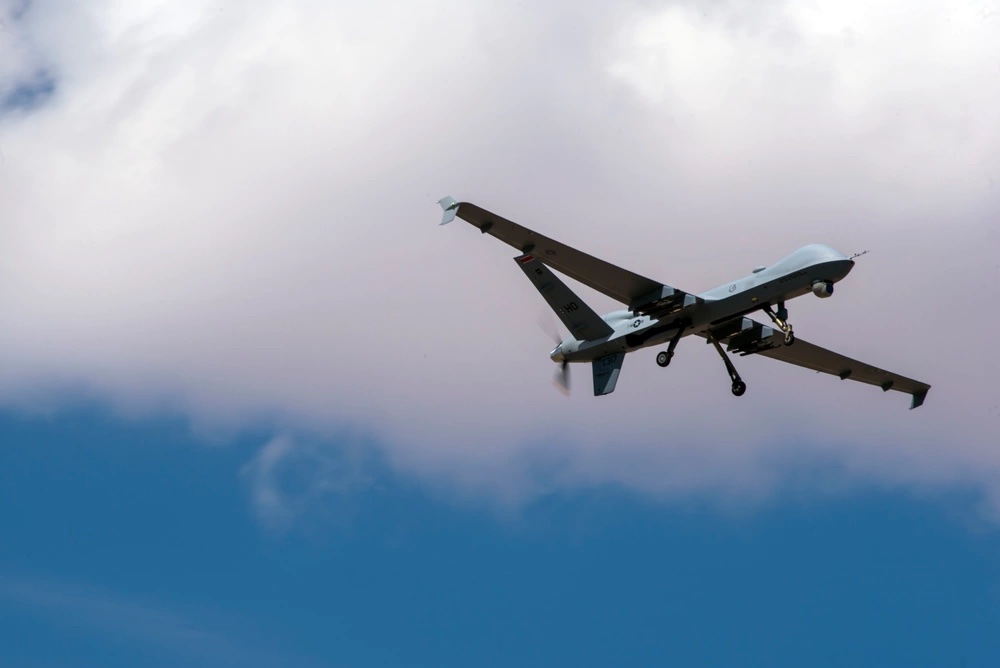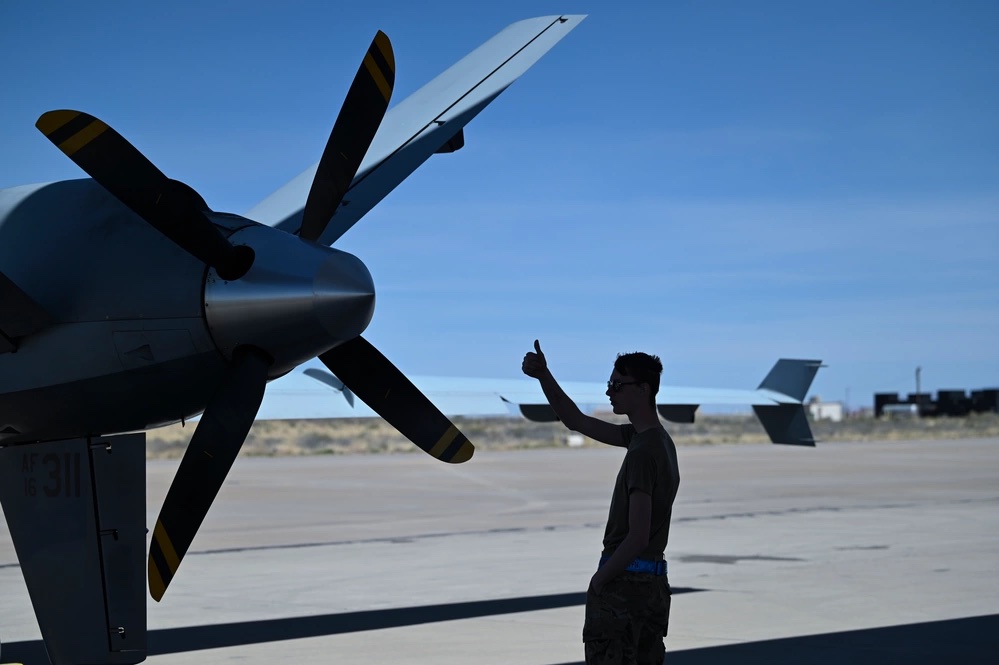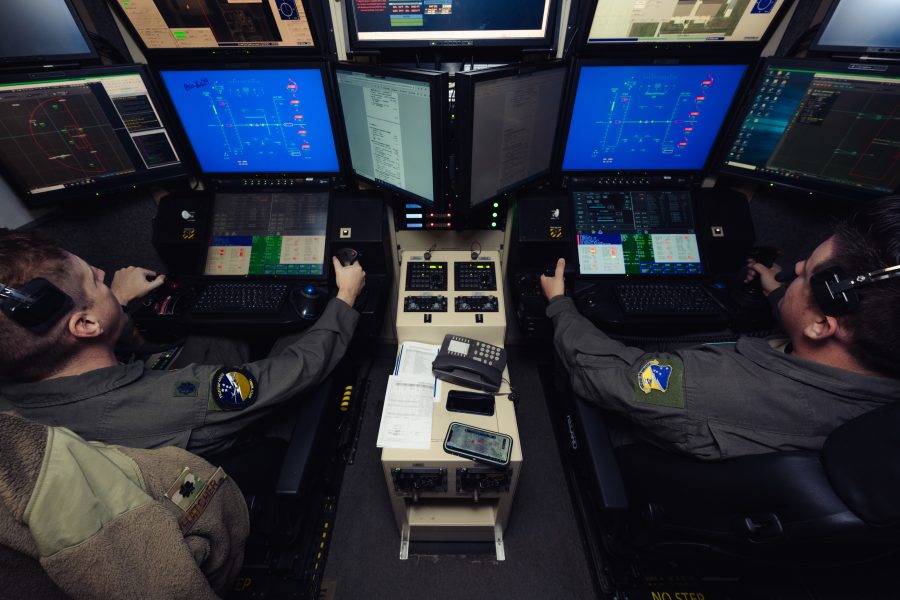MQ-9 drone student operators are now trained to land and take off via satellite, dramatically shrinking the footprint of personnel and equipment needed for Reaper operations.
Previously, Reapers have been flown by operators in faraway ground control stations but launched and recovered by Airmen closer to the runway. Now, the autopilot function known as the Automatic Takeoff and Landing capability (ATLC) can perform those tasks on its own, though it still requires a human crew to ensure safety of flight, Denise Ottaviano, a spokesperson for the 49th Wing at Holloman Air Force Base, N.M., told Air & Space Forces Magazine.
Students at the 49th Wing, the formal training unit for the MQ-9, demonstrated their skills from July 14 to July 24 at ACE Grand Warrior, an exercise where they landed two Reapers at Grand Forks Air Force Base, N.D. It was the first time the wing performed an entire mission under complete satellite communication control.
“The crews launching … are new to the launch and recovery realm,” Capt. Isabelle Perry, director of operations for the 29th Attack Squadron, said in a recent press release about ACE Grand Warrior. “This is important because they’re very young aviators in this field, flying in unfamiliar airspace, with a brand new mission set and they’re killing it.”
 A MQ-9 Reaper flies over Holloman Air Force Base, New Mexico, Aug. 13, 2020. U.S Air Force photo by Staff Sgt. Christine Groening
A MQ-9 Reaper flies over Holloman Air Force Base, New Mexico, Aug. 13, 2020. U.S Air Force photo by Staff Sgt. Christine GroeningThe exercise marks the latest development for ATLC, which the Air Force Reaper community has pursued since at least 2021, when the 556th Test and Evaluation Squadron proved the drone could take off and land without local ground control. In 2022, Airmen took the capability further by hopscotching a Reaper from Hawaii to Guam to Palau as part of the exercise Valiant Shield 2022.
The key advantage of ATLC is its smaller footprint. Past Reaper operations required sending about 55 maintainers with ground control stations, ground data terminals, and other equipment. Exercises like Valiant Shield and ACE Grand Warrior proved it can now be done with just 10 Airmen and a pallet and a half of gear, small enough to fit aboard a CV-22 Osprey or C-130 Hercules.
“There’s this monumental change in mindset, that I don’t need to pack all this stuff up and go,” Lt. Col. Michael Chmielewski, commander of the 556th TES, told Air & Space Forces Magazine last year. “I can go places just with a very small piece of maintenance equipment and less amount of people.”
The same mindset applied at ACE Grand Warrior, where just 10 maintainers from the 9th and 29th Aircraft Maintenance Units traveled to Grand Forks to sustain the visiting Reapers. The bite-sized deployment lines up with the Air Force’s push towards Agile Combat Employment (ACE), the operating concept in which Airmen and aircraft disperse from a central base to smaller, more austere locations in order to complicate an adversary’s targeting.
One tenet of ACE is Multi-Capable Airmen, where Airmen pick up skills outside their usual job specialty in order to reduce their footprint and promote redundancy if their unit takes casualties in a future fight.
At ACE Grand Warrior, Ottaviano explained, two of the avionics technicians who traveled to North Dakota were trained on satellite communications launch and recovery operations, engine runs, maintenance tasks, and pre- and post- flight inspections, which are typically performed by crew chiefs. The Airmen also used towing tractors and aerospace ground equipment already available at Grand Forks to further reduce their logistics tail.
“We just need a small box of tools, a plane or two, and a little box that helps us control the plane,” Staff Sgt. Ramon Chanhafen, an MQ-9 crew chief who traveled to North Dakota, said in a video about the exercise.

About 56 MQ-9 students took part in ACE Grand Warrior, where they ran the gamut of Reaper mission and training syllabus sets, including intelligence, surveillance, and reconnaissance; close air support; air interdiction; strike coordination and reconnaissance; basic surface engagement; kill-chain operations; and basic airmanship.
Today, all MQ-9 operators being trained at the 49th Wing are certified to conduct ATLC in a simulator, Ottaviano said. When graduates arrive at operational squadrons, they likely take part in “top-off” training to be certified on ATLC in live flight.
“Our future plans are to certify all students to conduct ATLC as an actual flight,” she said.
As the Air Force Reaper enterprise picks up ATLC, it should make coordinating future training exercises much easier. Unmanned flights through national airspace has “historically been tedious to coordinate with all the appropriate agencies,” Ottaviano explained. ATLC streamlines the process by removing the launch and land crew, along with the requirement for C-band or Line of Sight operations, since ATLC focuses on only satellite communications.
“This by itself frees up additional manpower and helps to narrow the focus on one type of communication frequency, thereby making the MQ-9 more agile and more flexible to conduct worldwide operations at a moment’s notice,” she said.


